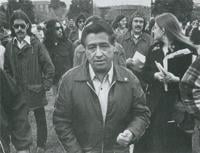
People stand in line to vote at the Joslyn Park vote center in Santa Monica on Nov. 5, 2024. (Photo by Apu Gomes, Getty Images)
It’s been six years since a judge ruled that Santa Monica’s election system discriminates against Latino voters. In that time, there have been at least three more elections — but the city hasn’t had to change the way it runs them.
That’s because the coastal Los Angeles County city appealed, and under current law, it’s not required to change the process until after all appeals are heard.
Assemblymember Anamarie Avila Farias thinks that needs to change.
“Even after the court determined an at-large election system is unlawful and radically discriminatory, the local body can hold even more elections utilizing their unlawful system by filing an appeal and paying attorneys to delay this process, during which time justice for communities of color is delayed and voters are disenfranchised,” the Democrat from Concord said at an Assembly Judiciary Committee hearing last week.
Under “at-large” election systems like Santa Monica’s, everyone who lives in a city votes on the same set of candidates. In a district-based election system, a city is divided into districts and voters choose from candidates vying to represent just their neighborhood.
Avila Farias’ proposal would mean courts would no longer automatically keep the current election process in place during the appeals process in cases related to the state’s voting rights act.
Sylvia Shaw, a lobbyist representing Santa Monica, said the proposal could force cities to repeatedly change their election systems as courts weigh the final outcome of a case.
That could include booting elected officials off the council, or forcing those who want to run to quickly raise money. Shaw said that could deprive voters of having anyone representing them for some period, and would be costly and confusing.
“It would result in an expensive and potentially temporary overhaul of a voting system that could leave minority voters in the city worse off than under the at-large system,” she told the committee.
Maria Loya, a former city council candidate who is a plaintiff in the 2016 case against Santa Monica, said the city continues to use taxpayer dollars to fight it.
“We’re trying to ensure that there’s a permanent representative from our neighborhood, and to ensure that candidates of color — in particular, Mexican Americans and Latinos — are able to not only run, but have an ability to win elected office,” Loya said.
Kevin Shenkman, an attorney who has fought dozens of cases to force more jurisdictions to switch from at-large to district-based voting, said the issue is not unique to Santa Monica, which is why a change in the law is necessary.
He’s trying a similar case against Huntington Beach in August that he expects will be resolved in favor of the plaintiffs, who argue that as in Santa Monica, the city’s at-large elections dilute Latino residents’ vote and prevent them from being able to elect a candidate of their choice. He thinks that the city will appeal as many times as it can.
“The Latino voters in Huntington Beach shouldn’t have to wait for their voting rights while the city of Huntington Beach appeals and appeals and appeals to cling to their power,” he said.
That’s why the legislation is not just about Santa Monica’s 92,000 voters, he said, but about all 39 million California voters.










(0) comments
Welcome to the discussion.
Log In
Keep it Clean. Please avoid obscene, vulgar, lewd, racist or sexually-oriented language.
PLEASE TURN OFF YOUR CAPS LOCK.
Don't Threaten. Threats of harming another person will not be tolerated.
Be Truthful. Don't knowingly lie about anyone or anything.
Be Nice. No racism, sexism or any sort of -ism that is degrading to another person.
Be Proactive. Use the 'Report' link on each comment to let us know of abusive posts.
Share with Us. We'd love to hear eyewitness accounts, the history behind an article.